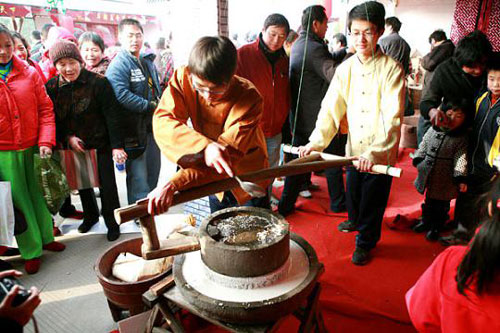
Water-soaked rice is milled into a milky paste that flows into a cotton-cloth bag, in the first step in making rice cake. (China Daily)
Ningbo rice cake comes in a mind-boggling variety of sizes, shapes and colors.
The color is important, as rice cake is often eaten on festive occasions. Rice cake is usually white when cooked in soups on the lunar calendar's New Year's Day, which is considered a day with a lot of yangqi, as white symbolizes positive energy associated with such qualities as brightness and warmth.
But on some occasions, you will come across rice cake in another color, such as red.
Red is believed to be an effective means of scaring away nian, a legendary beast that comes out at the end of a year to eat people, preferably children. Rice cakes with red stamps were regarded as a powerful talisman against the nian and other goblins and malignant spirits, and stewed with red beans and other sweet ingredients, a bowl of rice cakes helped people endure the winters.
Slices of rice cake are also used as bricks in tabletop towers, which people believe bring peace and good luck when eaten. Many families eat rice cake in the shape of a fish dyed like a rainbow with edible colors in the hope that the rice cakes will bring a "good catch" in the coming year.
Cicheng has a museum that displays the tools and manufacturing processes used to make rice cake, which is the only museum of its kind in East China.
"Rice cake is deeply ingrained in day-to-day activities of Ningbo people all around the world, and the museum is a nice place to share the feelings of this group," said Wang Hui, a guide at the museum.
No matter how a piece of rice cake is fried, baked, toasted, steamed, stewed or grilled, the white glutinous ingredient must first undergo a process that may take up to three days.
Harvested rice is soaked in a huge water tank until it is soft enough to be milled without much effort. Water milling takes at least two people - one to grind, the other to add water to the ground rice until it becomes a milky paste that flows into a cotton-cloth bag. Squeezed rice paste is then put into a bowl in a wooden container and steamed.
